| 1 | Madurai shield-tail snake |
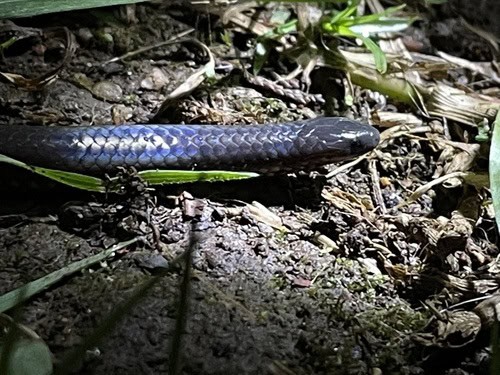
The Western Ghats is a mountain range found in southwest India, which are renowned for their long list of rare and often bizarre species found nowhere else. There’s so many endemic snakes in the western Ghats that scientists simply don’t have the manpower to research them all, and one massive blind spot is the Madurai shield-tail (Platyplectrurus madurensis).
Madurai shield-tail snakes exclusively inhabit the western Ghats, and then just a small portion of it. They’re confined to the Palani Hills, directly east of the Anaimalai Hills, which contain southern India’s highest peak.
The Madurai shield-tail was originally found near Kodaikarnal, a scenic town which lies at 2000 metres. This snake is a glistening purplish-brown, contrasting vividly against a bright yellow underside. Each yellow scale has a thick dark outline. This is a small snake which averages at just 44cm, and only appears above 1200m in elevation. Madurai shieldtails are shy, and are usually found below some sort of cover. They’ve been found below rocks in mountainous shola forest patches, under rocks in mountainous grassland, and below fallen logs.
Despite being so secretive, the Madurai shield-tail has been known to scientists for a long time. The original family member Platyplectrurus trilineatus was described in 1867, and Platyplectrurus madurensis followed a decade later in 1877. Progress rapidly ground to a halt, as the Platyplectrurus family still has 2 members as of 2024. Both remain extremely mysterious.
| 2 | Black coral snake |
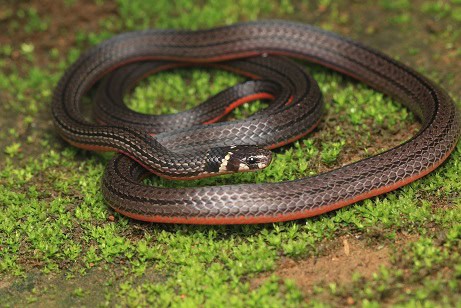
This venomous snake averages at 55cm, with a confirmed maximum of 115cm. The black coral snake (Calliophis nigrescens) lives at altitudes of 1000-2300 metres, usually in wet forests, occasionally on tarmac in the form of roadkill.
This is a red-black snake, arranged in parallel lengthways stripes, with some morphs having more red than others. One of their special features is the underside of their tail, which is bright white and red, like a candy cane. Resist the urge to suck it though. Like all Calliophis members, black coral snakes have a neurotoxic venom, and touching them is the only instance in which they might bite. Black coral snakes are timid creatures, and prefer rapid flight to engaging in conflict.
There are no confirmed humans deaths from this species, or even severe envenomation, one reason being its mainly underground habits. When encountered in forests, black coral snakes are nearly always half buried in a mixture of soil, fallen leaves and rotting branch debris. Most of their diet is fellow snakes, supplemented with lizards.
Their exact venom potency is mysterious, but you don’t want to be the first to find out. Their relative the Malaysian blue coral snake also causes virtually no bites, yet once killed a showering Singapore man in 5 minutes. Be cautious of any red-black striped snakes you see in the western Ghats.
| 3 | Malabar pitviper |
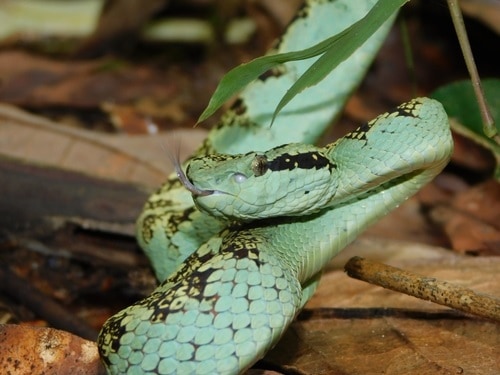
The most likely pitviper to strike at you from a branch. Malabar pitvipers (Craspedocephalus malabaricus) are endemic to the western Ghats, where they cover a large territory. They average at 40-80cm, and spend virtually all their lives on branches. It’s extremely rare to find them on the forest floor, slithering through leaves, though they do occasionally enter streams and coil around submerged branches, not realizing they’re underwater.
Malabar pitvipers rarely kill their victims, but have a dangerous venom which can unleash painful swelling and haemorrhaging. The vast majority of their prey are frogs, of which they can swallow multiple individuals at once. Confirmed prey include Malabar gliding frogs and Indian bullfrogs.
Like the best ambush predators, Malabar pitvipers can spend weeks at a time on a branch perch without moving. If you disturb them, the consequences will be a rapid lunge, with bared fangs that get steadily larger as they approach your face. Whether you spot them first depends on their exact morph, for this is an incredibly variable snake. Malabar pitvipers range from bright blue to jungle green to tree trunk brown to brick red. The reasons for this polymorphism are unknown.
Craspedocephalus malabaricus is a widespread species which can appear in virtually any Western Ghats forest, though they’re never found outside of forests.
| 4 | Olive forest snake |
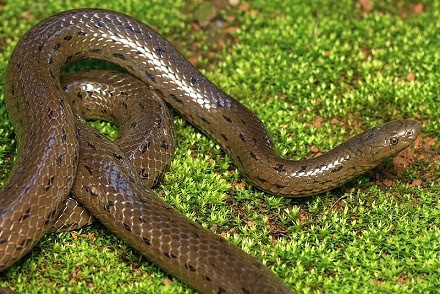
A probably harmless snake which is never found in dry areas, always sticking closely to water bodies. Olive forest snakes (Rhabdops olivaceus) are non-venomous or mildly venomous, and reach a maximum of 98.5cm.
This is a snake of mountain streams in rainforests, whether flowing gently or in a torrent from recent downpours. They also inhabit more open land, if there’s sufficient rainwater pools to move between. This is a docile snake which is more likely to stare at you inquisitively than launch into a savage bite.
Rhabdops olivaceus has very smooth scales to touch. From above, they have glistening green olive shades, while their belly is a purer yellow, with black flecks along the flanks. Their eyes are also green olive, with round pupils.
While loving forest depths, they can also be found in water bodies near villages and rice paddy fields. Olive forest snakes are common in the western Ghats, yet remain relatively unsearched.
This is a mainly nocturnal snake, but capable of hunting during day occasionally. In a 2014 study, 6 individuals were found, and all were resting during the day, always hiding below waterlogged rocks. A 2012 report was contradictory, observing several moving from 8:05 to 14:15 during rainy season. Olive forest snakes rely heavily on seasonal water pools, meaning that they probably become more adventurous during monsoon season.
| 5 | Horseshoe pitviper |
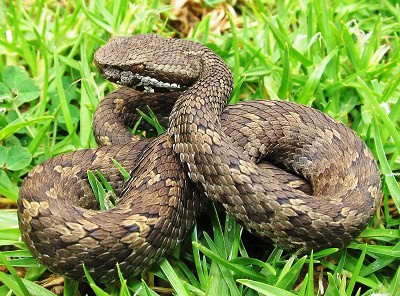
One of India’s rarest pitvipers. Horseshoe pitvipers (Craspedocephalus strigatus) are a ground-dwelling species, rarely appearing on branches. This species occupies altitudes of 1100-2400 meters, where they appear in forests, but especially shola grasslands. Within these realms, horseshoe pitvipers are often spotted resting menacingly on rock slabs.
Horseshoe pitvipers belong to the same Craspedocephalus family as the Malabar pitviper, their western Ghats neighbour. But this species is 1) far less colourful and variable, and 2) restricted to a dramatically smaller range. This may be the rarest pitviper in all of India, as it’s endemic not just to the western Ghats, but the Nilgiri mountains subrange of Tamil Nadu and Kerala. Their favoured shola grassland habitat has shrunk by two thirds over the last century, in turn shrinking the horseshoe pitviper’s range.
Compared to Malabar pitvipers, there’s just a tiny fraction of encounters with humans, and they have zero presence in India’s annual snakebite statistics. Its venom is theorized to be haemotoxic rather than neurotoxic.
Horseshoe pitvipers have standard brown-grey viper shades, and peak at just 55cm. The horseshoe title comes from a single marking atop their head, rather than their body blotches.
| 6 | Anamalai wood snake |
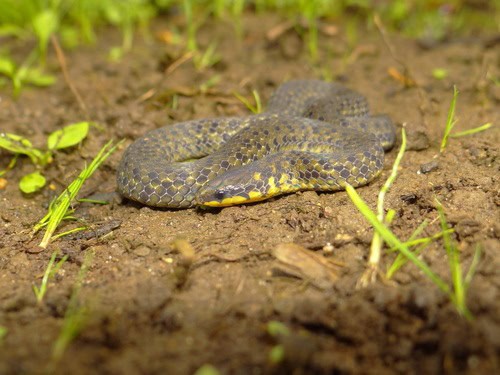
One of 5 Xylophis woodsnakes found in India, and the most recently discovered. The scene was Kerala state’s Eravikulam National Park. It was December, and researchers Sandeep Das and K.P. Rajkumar had spent the entire morning trudging up hillsides surveying the local areas for snakes. Exhausted, they sat down on the grass, when Das spotted a strange movement ahead. It was a ground-dwelling wood snake, but an odd one, which looked different to the Perrotet’s wood snake further north.
After 5 years of further study, they announced in 2020 that they’d discovered an all new species: the Anamalai Wood Snake (Xylophis mosaicus). It was named after the Anaimalai Hills, home to southern India’s highest mountain, the moderately mighty Mount Anamudi at 2695 metres.
So far, the Anamalai wood snake is known only from 1500 metres in altitude or higher. They average at 30cm, with a maximum of 44cm, and are a burrowing species which requires soft soils. Unlike Perrotet’s wood snake, they have a complex mosaic of patterns, with rapidly alternating yellow, black and dark olive scales. The reason for the split is the Palghat Gap, the widest gap in the Western Ghats mountain range at 30km long. This lowland gap forced many species to separate and diverge, from snakes to bush frogs. Anamalai wood snakes are non-venomous, and a great achievement for any reptile nut to track down.
| 7 | Spotted earth snake |
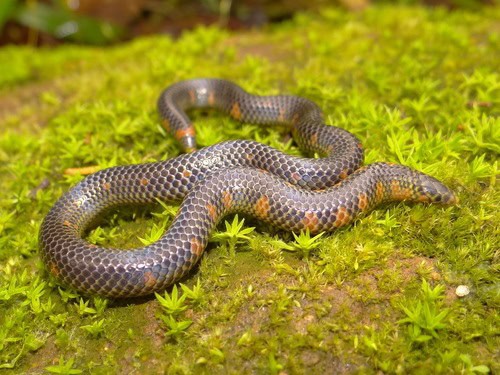
The western Ghats not only have wood snakes, but earth snakes too, although no fire or ice snakes have been discovered (yet). The spotted earth snake (Uropeltis maculata) is a rarely seen species which is known from altitudes of 1065-2400 metres. This is part of the 24-member Uropeltis family, all found in India, and all extreme burrowers, with a classic tapering head, which is far more optimized for shifting soil than the rounded head of a cobra.
Uropeltis maculata are mainly chocolatey brown from above, to blend in with soil from a bird’s eye view. But their flanks are more colourful, gaining pastel yellow and red, the latter seperating them from other Uropeltis members. Their belly is a bright yellow.
Like other shield tails, Uropeltis maculata is often mistaken for a worm, as it reaches a maximum length of just 39cm, though this is actually large for a Uropeltis. Its head and tail are almost identical in shape. Just as their skull tapers to a sharp point, enabling them to burrow, so does their tail. Like most Uropeltis members, spotted earth snakes are believed to prey on earthworms. Your chances of meeting this snake are very low, but perhaps you’re up to the challenge.
| 8 | Whitaker’s boa |
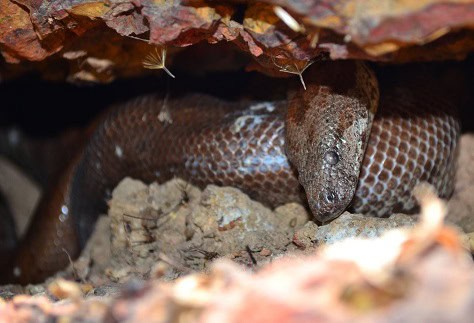
A burrowing boa which rarely exceeds 70cm, and peaks at 100cm. Whitaker’s boa (Eryx whitakeri) lives only in southwest India, including in Kerala, Karnataka, Goa, and Maharashtra states.
This species avoids the highest regions of the western Ghats, sticking to moderate elevations. However, they’re also found close to shores, including on beaches, where they utilitise their excellent burrowing abilities. This is a relative of the infamous Arabian sand boa, which digs in desert sand dunes, stretching as far as the eye can see, but Whitaker’s boa lives in less extreme habitats.
Confirmed prey include fellow snakes like the common vine snake, though they mostly feed on small mice, which they pounce on from ambush positions. One of Whitaker’s boa’s confirmed habitats is the campus of Goa university, where an Indian krait (Bungarus caerulus) was spotted devouring one. The boa measured 45cm and the krait 128cm; the latter eats fellow snakes as a large chunk of its diet.
Whitaker’s boa has very small eyes, with vertical pupils. This species also coexists with a relative, the rough-scaled sand boa (Eryx conicus), which is much more widespread in India, covering most of the nation. The difference is that Whitaker’s boa has far smoother scales, and its blotches tend to be more faded, less vivid.
| 9 | Nilgiri keelback |
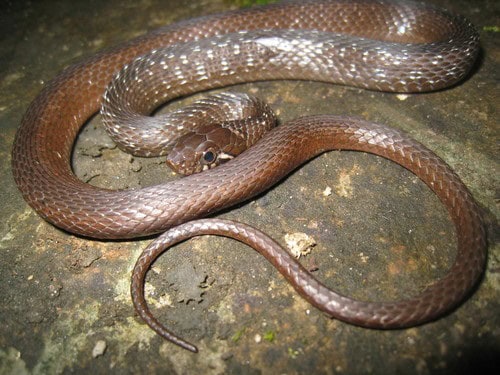
Many entries on this list are rare, and inhabit one particular hill range within the western Ghats, but the Nilgiri keelback (Sahyadriophis beddomei) inhabits virtually the whole thing. Their range is simply a huge spine stretching down southwest India, and they occur nowhere outside these hills.
Nilgiri keelbacks have a toffee brown base overlaid with white and occasionally black speckles. This is a species of water, as while not fully aquatic, they’re nearly always found on the banks of streams and forest pools. Their main homes are tropical rainforest and tropical moist forests, and the higher the annual rainfall in an area, the more likely they are to appear. Most of their diet is amphibians, with two confirmed prey being Jog’s night frog (Nyctibatrachus jog) and Ghate’s shrub frog (Raorchestes ghatei).
This species originally belonged to the large Hebius keelback genus, but was switched to the smaller Sahyadriophis in 2023. Nilgiri keelbacks move by day and have round pupils. They were first discovered in 1864, and it’s rare to find them climbing trees.
| 10 | Bibron’s coral snake |

Another Calliophis family coral snake. Bibron’s coral snakes (Calliophis bibroni) occupy the southern half of the western Ghats, appearing at relatively low elevations of 0-1220 meters rather than the towering mountaintops. Like black coral snakes, they contribute virtually nothing to the Western Ghats’ annual snakebite totals, and their venom is completely unresearched.
The territories of the two cousins overlap, but they’re extremely easy to separate. Bibron’s coral snake has the same red-black colours as the black coral snake, but its patterns are the reverse, forming encircling bands rather than lengthways stripes.
Bibron’s coral snakes are medium sized, averaging at 40-60cm. A 2010 study discovered a new record by stumbling across a 88cm male. This was found by a riverside habitat, and was already dead, with puncture wounds on its body, seemingly inflicted by a bird’s talons. A second large male was found accidentally, while a scientist was digging in earth for caecilians. A female was found crossing a road within an evergreen forest, while another large male was collected along the main trail of Anamalai Tiger Reserve. Bibron’s coral snakes have a distinctive belly, with a bright red or pinkish red colour overlaid with black squares.
